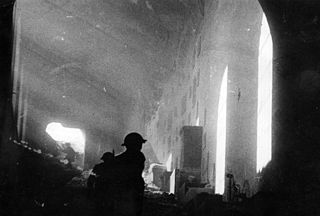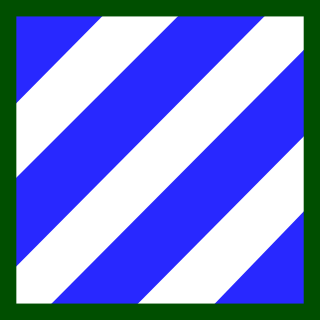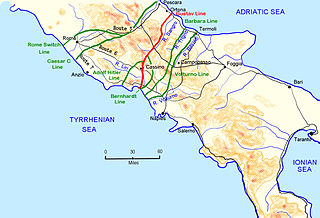
The Battle of Monte Cassino, also known as the Battle for Rome, was a series of four military assaults by the Allies against German forces in Italy during the Italian Campaign of World War II. The objective was to break through the Winter Line and facilitate an advance towards Rome.

The 3rd Infantry Division (3ID) is a combined arms division of the United States Army based at Fort Stewart, Georgia. It is a subordinate unit of the XVIII Airborne Corps under U.S. Army Forces Command. Its current organization includes a division headquarters and headquarters battalion, two armored brigade combat teams, one aviation brigade, a division artillery, a sustainment brigade and a combat sustainment support battalion along with a maneuver enhancement brigade. The division has a distinguished history, having seen active service in World War I, World War II, the Korean War, and the Global War on Terror. The Medal of Honor has been awarded to 61 members of the 3rd Infantry Division, making the division the most honored in the Army.

The Battle of Anzio was a battle of the Italian Campaign of World War II that commenced January 22, 1944. The battle began with the Allied amphibious landing known as Operation Shingle, and ended on June 4, 1944, with the liberation of Rome. The operation was opposed by German and by Italian Repubblica Sociale Italiana (RSI) forces in the area of Anzio and Nettuno.

General Lucian King Truscott Jr. was a highly decorated senior United States Army officer, who saw distinguished active service during World War II. Between 1943–1945, he successively commanded the 3rd Infantry Division, VI Corps, Fifteenth Army and Fifth Army, serving mainly in the Mediterranean Theater of Operations (MTO) during his wartime service. He and Alexander Patch were the only U.S. Army officers to command a division, a corps, and a field army in combat during the war.

The Winter Line was a series of German and Italian military fortifications in Italy, constructed during World War II by Organisation Todt and commanded by Albert Kesselring. The series of three lines was designed to defend a western section of Italy, focused around the town of Monte Cassino, through which ran the important Highway 6 which led uninterrupted to Rome. The primary Gustav Line ran across Italy from just north of where the Garigliano River flows into the Tyrrhenian Sea in the west, through the Apennine Mountains to the mouth of the Sangro River on the Adriatic coast in the east. The two subsidiary lines, the Bernhardt Line and the Hitler Line, ran much shorter distances from the Tyrrehnian Sea to just northeast of Cassino where they would merge into the Gustav Line. Relative to the Gustav Line, the Hitler Line stood to the northwest and the Bernhardt Line to the southeast of the primary defenses.

Anzio is a town and comune on Lazio coast region of Italy, about 51 kilometres (32 mi) south of Rome.

The 1st Special Service Force was an elite joint American–Canadian commando unit in World War II, formed by Lieutenant Colonel Robert T. Frederick of the Operations Division of the U.S. General Staff. During the Italian campaign of World War II, it was commanded by Frederick and attached to the United States Fifth Army. In August 1944, the Force was attached to 1st Airborne Task Force for the campaign in southern France.

Nettuno is a town and comune of the Metropolitan City of Rome in the Lazio region of central Italy, 60 kilometres south of Rome. A resort city and agricultural center on the Tyrrhenian Sea, it has a population of approximately 50,000.

The Italian campaign of World War II, also called the Liberation of Italy following the German occupation in September 1943, consisted of Allied and Axis operations in and around Italy, from 1943 to 1945. The joint Allied Forces Headquarters (AFHQ) was operationally responsible for all Allied land forces in the Mediterranean theatre and it planned and led the invasion of Sicily in July 1943, followed in September by the invasion of the Italian mainland and the campaign in Italy until the surrender of the Axis forces in Italy in May 1945.
The D-Day Dodgers were Allied servicemen who fought in Italy during the Second World War. The D-Day Dodgers also inspired a popular wartime soldier's song.

The Florence American Cemetery and Memorial is about 7.5 miles south of Florence, Italy, about two miles (3 km) south of the Florence-Impruneta exit of the Rome-Milan autoroute. It covers about 70 acres (28 ha), chiefly on the west side of the Greve river, framed by wooded hills.

Madras War Cemetery is located in Nandambakkam, Chennai, Tamil Nadu, India. It was created to receive Second World War graves from civil and cantonment cemeteries in the south and east of India where their permanent maintenance could not be assured.

Sicily–Rome American Cemetery and Memorial is a World War II American military war grave cemetery, located in Nettuno, near Anzio, Italy. The cemetery, containing 7,858 American war dead, covers 77 acres (31 ha) and was dedicated in 1956. It is administered by the American Battle Monuments Commission.

The Bayeux War Cemetery is the largest Second World War cemetery of Commonwealth soldiers in France, located in Bayeux, Normandy. The cemetery contains 4,648 burials, mostly from the Invasion of Normandy. Opposite this cemetery stands the Bayeux Memorial which commemorates more than 1,800 casualties of the Commonwealth forces who died in Normandy and have no known grave.

The 65th Infantry Division was a German division in World War II. It was formed in July 1942.

Essex Farm Cemetery is a World War I, Commonwealth War Graves Commission burial ground within the John McCrae Memorial Site near Ypres, Belgium. There are 1,204 dead commemorated, of which 104 are unidentified. The cemetery was designed by Sir Reginald Blomfield and has an area of 6,032 square metres (64,930 sq ft).

The Beach Head War Cemetery near Anzio is a Commonwealth cemetery of the Second World War. It contains graves resulting mostly from Operation Shingle and subsequent military actions in Italy.
The I Fallschirmkorps was one of the main German Luftwaffe Corps during World War II.

The Cerisy-Gailly Military Cemetery is a military cemetery located in the Somme region of France commemorating British and Commonwealth soldiers who fought in World War I. The cemetery contains mainly those who died on the front line near the village of Cerisy between February 1917 and March 1918 and during the Allied recapture of the village in August 1918.


















